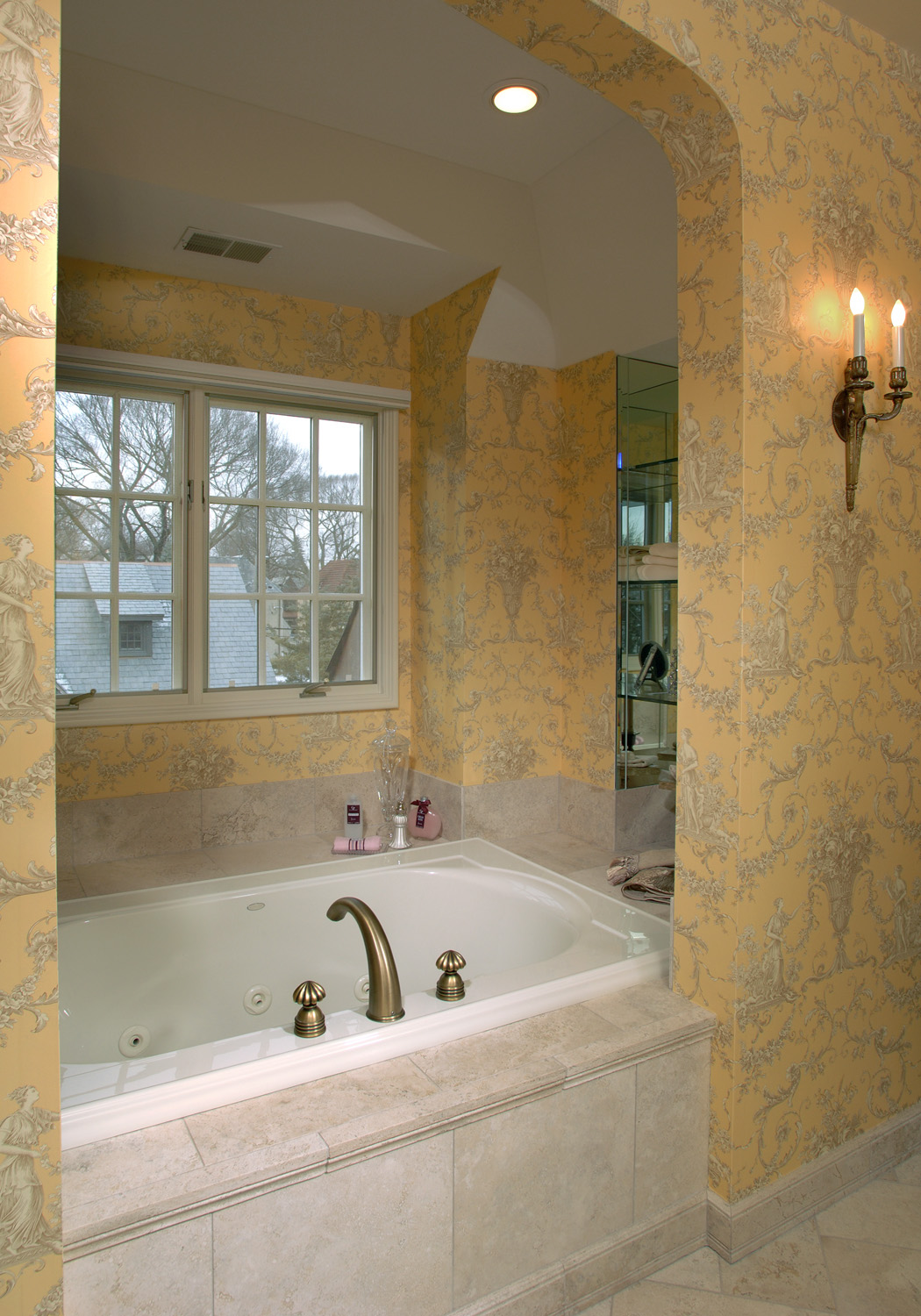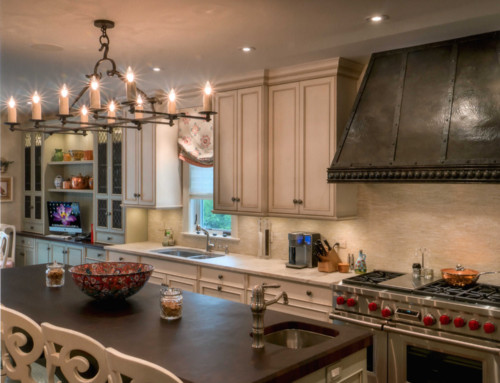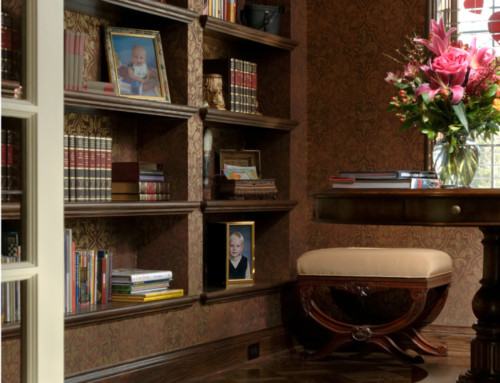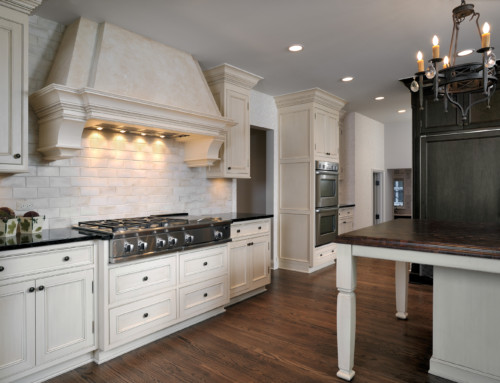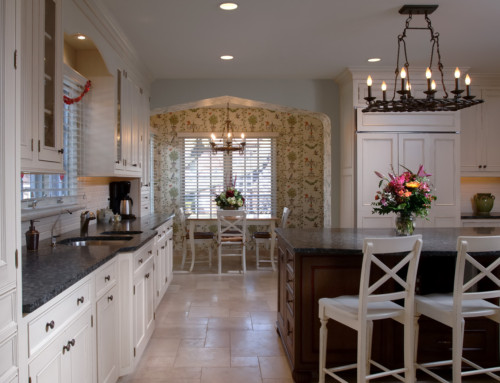By LIZ JAROS
When 1326 William St. in River Forest came on the market in 2004, its listing sheet urged potential buyers to “bring decorating ideas.” Enticed by the home’s old world facade and hooked by its rock solid construction, home builder Jane Levy soon found herself parked in the driveway with truckloads of them.
“Originally, I was just planning to do the kitchen and baths and resell,” says Levy, a River Forest resident and A.S.I.D. member who runs her own high-end, custom home-building business. “But this was going to be my second remodel and my first
With her vision and her expenditures growing daily, Levy soon found herself taking the home down to its studs and completely starting over inside. Working with a traditional Tudor exterior featuring a steeply pitched roof, exposed wooden timbers and slender, diamond-pane windows”building characteristics representative of 16th century England but actually rooted in Medieval design”Levy knew she wanted to incorporate some of the home’s basic architectural elements into the interior. But she also knew her potential buyers would be looking for modern bells and whistles.
The effort, it turns out, was a success. Levy & Biltmore, Levy’s design and home-building firm, just won two awards from The Home Builders Association of Greater Chicago, a not-for-profit trade association that represents members involved in all phases of residential construction. Levy received this year’s gold key for excellence in housing design and a crystal key for innovation and creativity.
“In a situation like this,” she says, “the trick is to build everything new and make it look old.”
In the formal reception hall, where brown vinyl tiles were removed to reveal a terrazzo marble floor, Levy had reproduction guest closet doors fashioned after the original oak front door. Throughout the home, wherever possible, Tudor arched entryways and wall niches were employed to maintain a dash of English character. Original trim-lines and molding patterns were also painstakingly replicated.
“We kept the rich stain on the wood floors and the staircase banister,” says Levy. And period-appropriate light fixtures were selected for the formal spaces. An orange fireplace hearth in the living room was replaced with a creamy stone update, and the walls were dressed with pale colors to contrast with a dark, ¾-inch thick parquet floor.
In the powder room, which Levy says should always be “the jewel of the house,” an Art Deco vanity with a biscuit white sink is paired with toile wallpaper in a soft yellow hue. And while these materials probably would not have been utilized in an Elizabethan era water closet overhaul, they certainly would have been appropriate choices for installation in 1936, when this home and many others like it were being built in the United States.
After securing a buyer about two-thirds of the way through the overhaul, Levy and company found that they needed to make some changes to the home’s original space. At the request of her clients—a professional couple with young children—the back of the home was opened up to make way for a family room, sunroom and kitchen expansion.
Admittedly “a little controlling” with her jobs, Levy says changing course slightly at this point was not a problem because her clients were so great. “I’d call these people up and go, ‘Oh I just added a blah, blah, blah in the bathroom’ and they’d say, ‘Fine. We trust you.'”
So while a sunken family room with a vaulted ceiling and a sunroom with a heated tile floor were not exactly Tudor style, Levy knew she could detail the space with materials and techniques that would complement the existing rooms and evoke a mood appropriate to the home’s heritage.
“For the wet bar, which was custom-made, we used this granite that looks like pressed glass,” says Levy. “We wanted it to look classic but feel new.” An imposing limestone fireplace, designed by Levy, was employed to achieve the same effect.
In the kitchen, a subway-tile backsplash provides a nod to the 1930s, while painstakingly-selected light fixtures and period wallpaper echo English style. A honed granite countertop (a technique where the shine is removed) employs modern material for a vintage appearance, while a counter-camouflaged, roll-out martini bar and an adjacent, first-floor laundry room hit contemporary notes.
“Being a female in my line of work has its advantages,” says Levy. “I know how to entertain and how to set a house up for convenience.”
She also clearly knows a thing or two about luxury. A brand new detached, three-car garage can actually house six automobiles thanks to a stacking feature. And the home’s blue stone front porch is equipped with an internal heater to melt snow and ice before they have time to create inconvenience.
Off the master bedroom, a set of massive his-and-hers closets is fit for a modern wardrobe, and a toile-drenched master bath is fit for British royalty. In here, a sky-lit whirlpool tub aligned with a flat-screen TV seems perfectly at home with a set of freestanding, antique brass vanities. Like the other two bathrooms on the second story, this one comes equipped with a heated tile floor.
“It’s the little things that matter,” according to Levy, who says the last thing she typically does in a house is bring an artist through to faux paint outlet covers and air returns. “Why do anything ordinary?”
READ THE FULL STORY HERE

